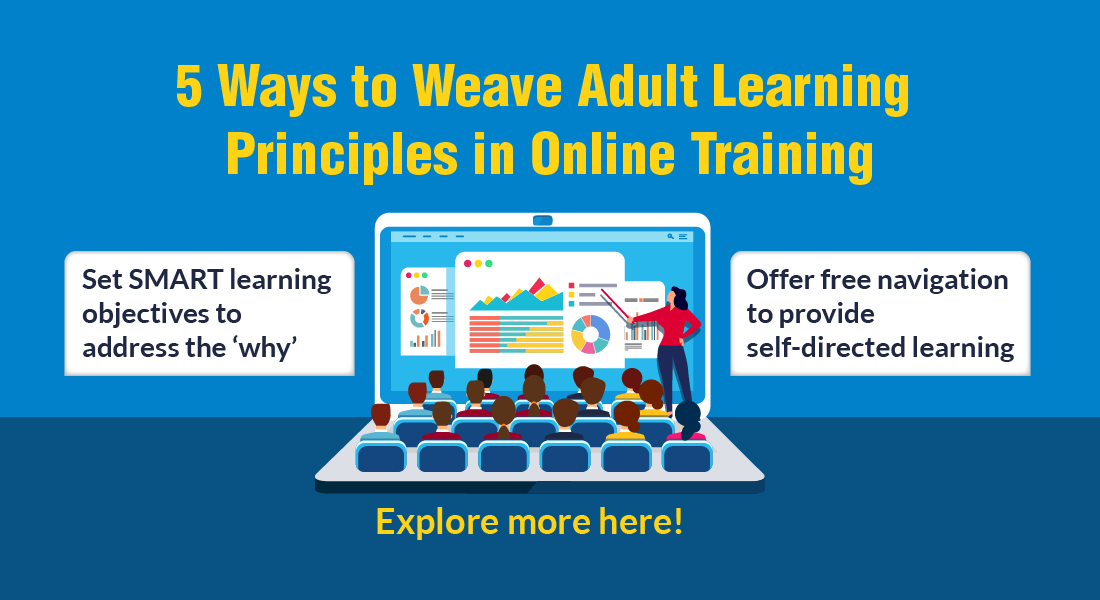5 Adult Learning Principles: The Secret Behind Successful Online Training

Learning is a process. True! For we have been learning for a long time now – right from pre-school to the workplace. Here’s a question. Do you think how you approached learning as a child is the same as how you approach it now? No, of course not! Learning as a child and learning as an adult are two very different things, which is why we have two different terms for them – ‘pedagogy’ and ‘andragogy’. However, andragogy or adult learning principles are the foundations for an effective corporate online training design.
Follow 5 Principles of Adult Learning for Effective Online Training
- Inform learners ‘why’ the training is important
- Provide scope for self-directed learning
- Enable learners to connect prior knowledge
- Implement a problem-solving training approach
- Encourage learners with rewards and recognition
Explore a one-stop guide to become an eLearning champion in your organization.
The terms pedagogy and andragogy (from Greek) have a common root word ‘ago’ which means ‘to guide’. The other root words are ‘paidi’ (meaning child) and ‘andras’ (meaning man).So, pedagogy is the practice of teaching children and andragogy is the practice of training adults.
I don’t mean to geek out with all this Greek, but I am fairly certain you have had the terms thrown around during many L&D conversations.
But How Different is Andragogy from Pedagogy?
And why does it matter?
Teaching children is very different from teaching adults. For starters, children are free of pre-conceived ideas and prejudices which make them more open to learning. They are also curious to constantly learn new things, no matter how useful or practical.
Adults on the other hand, are selective about what they want to learn; their learning not driven by curiosity as much as by utility. And most importantly, adults already have years of experience and knowledge that shapes their perspectives and hence are not as open to learning as children.
All these characteristics of adults come into play during training. Understanding adult habits and expectations is the first step toward designing a successful adult learning program.
American educator Malcolm Knowles proposed 5 principles of adult learning. Based on those principles, here are 5 aspects of andragogy that you can weave into your online training.
5 Principles of Adult Learning that your Online Training Needs to Address
1. The Need to Know – the ‘Why’ of Learning
Do you remember your school years? There were so many subjects to study – math, biology, history, language, and literature. And yet, we never really questioned why we had to learn everything, did we? After all, we were exploring our options then, learning anything and everything just because we are told that they will be of some relevance to us in the future. (Even thought I still can’t figure out how the endless torture of calculus is of any use to me.)
But as adults, we don’t learn simply because we are told to, we learn only when we want to. Adult learning is not so much about exploring as it is about, ‘Why is this important?’ or ‘How will this knowledge benefit me?’
Corporate training is even more specific. Workplace learning is not implemented just for the sake of learning but because it serves to hone employees’ job skills. So, the first and most important rule for an engaging and effective online training program is to answer this simple question for learners – “What’s in it for me?”
The best way to go about that is through SMART Performance-based Learning Objectives that inform learners what will be able to do (perform) after they finish a given course.
Learning objectives need to be SMART – Specific, Measurable, Achievable, Relevant, and Time-bound. Sounds complicated? Let’s simplify this.
- Specific: Learning objective should give precise and clear information on what the learner will be able to do by the end of the course.
- Measurable: Learning objectives need to focus on actionable results which can be observed and measured.
- Achievable: Learning objectives should be realistic and attainable.
- Relevant: Learning objectives should be relevant to the course content as well as to the learner’s job requirement.
- Time-bound: Learning objectives should convey the time frame in which the job needs to be done.
2. The Need for Self-directed Learning
As we discussed earlier, teaching children is all about encouraging them to explore; to nurture their natural curiosity and find different and unique ways of gaining knowledge. But this exploration can’t be completely without direction – which is why children need hand holding and later as young adults, they are directed by academic curriculums and canons. But adults don’t – they prefer to walk their own road.
Adult learning is most successful when it is self-directed and not forced. This self-directed learning can be driven by either interest or utility; but the reins need to be in the learner’s hands. How can your employee training be self-directed? Well…here are your answers.
With the world becoming more and more digital, the line between work and personal life is getting blurred. And with the mobile revolution, accessing information has never been easier. Today’s employees prefer learning that can be accessed anytime and anywhere they want based on their convenience.
With mobile learning, learners can take control of the ‘where’ and ‘when’ of their own training.
Another way through which you can facilitate self-directed learning is through a learner-friendly GUI and free navigation. This will free learners from the restrictions of taking the course/module in the order dictated by the trainer.
While some eLearning compliance courses are mandatory, you can always keep your course library open for employees who seek to take courses based on their interests.
3. The Need to Connect New Information with Existing Learning
John Locke, the famous sixteenth century English philosopher, talks about the ‘theory of tabula rasa’ in his ‘An Essay Concerning Human Understanding’. Tabula Rasa is Latin for a ‘clean slate’. According to this theory, the mind is like a clean slate at birth. When we learn as children, we do not have any pre-conceived notions of the world, or experiences which can influence our understanding. Hence learning is easy to absorb and doesn’t need much reflection or connection.
However, learning as an adult is a completely different experience. Adults are by no means blank slates. They are the product of their education, environment, nature, and experiences. These factors influence our ability to learn. That is why connecting new information to prior knowledge is so important. Without building such connections, learning will become a fragmented process.
There are many ways of connecting new information to previous knowledge within online training.
- Pre-assessments give learners an opportunity to recap what was already learned and check how much of it they remember.
- Refresher courses allow learners to reinforce learning after a long gap and help them beat the forgetting curve.
- You can also help learners connect between new information with previous training by maintaining a chronology and uniformity in training content.
4. The Need for a Problem-solving Approach
We have already established that adult learning is driven by utility and that adults need to connect new information with existing knowledge. The fourth principle of andragogy is based on these two concepts. What drives adult learning more than anything else is a need to solve problems. To learn how to solve job-related problems, learners need to connect information gained from training to real-life applications.
Online training is deemed successful only when employees can translate knowledge to job-skills. There is growing discussion within L&D on how learning processes can be made more experiential where learners don’t just passively gain information but actively experience learning. Here are a few instructional design strategies which can make that happen.
- Case studies: Learners are given a real-life/fictional problem. They get to understand the cause of the problem, how it will affect their work, and how to solve it.
- Branching Scenarios: Learners are presented with a scenario where they have to make key decisions, each decision followed by a specific consequence. This way employees will learn how their actions can have consequences.
- Simulations: eLearning courses are designed to mimic job environments and conditions to give learners an opportunity to learn, explore and practice in life-like situations.
5. The Need for Rewards and Motivators
People often talk about how there is no reward without work. True! But the opposite is also true. The promise of reward is what drives most people to work harder. This is especially seen in adult learners in a corporate training setting. Friendly competition among peers and the gratification of winning is often the best motivator for employees to finish training with flying colors.
Gamification elements in online training like reward points, leaderboards, scores and levels, as well as the good old incentives of bonuses and promotions increase employees’ self-esteem, influence, and growth.
Summing it Up!
Now that you’re privy to all these secrets of adult learning, what next? Have you been implementing them already? If not, you must be eager to try these principles in your training program immediately.
If you want more insights about eLearning design and development and how you can make your workplace training more learner-centric and effective, we have an awesome book for you to read.





![Create Efficacious eLearning Courses by Understanding How Adults Learn [Infographic]](https://blog.commlabindia.com/hubfs/Imported_Blog_Media/Adult-Learning-Principles-%E2%80%93-An-Info-graphic.jpg)